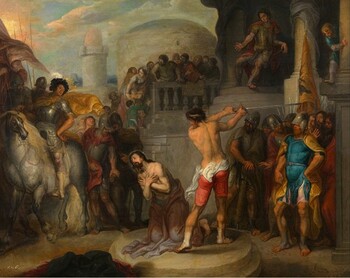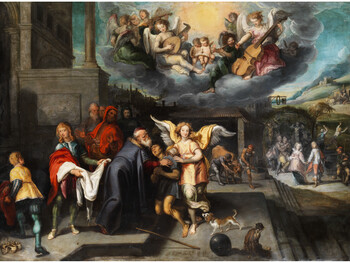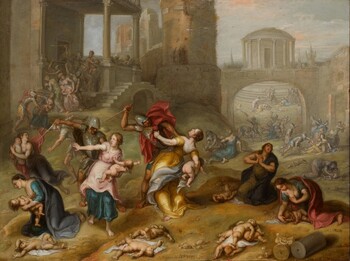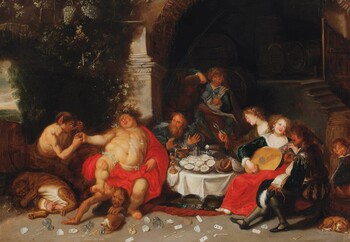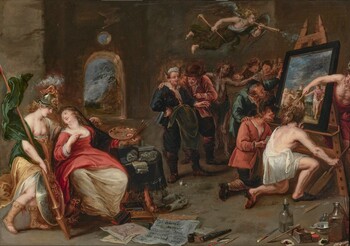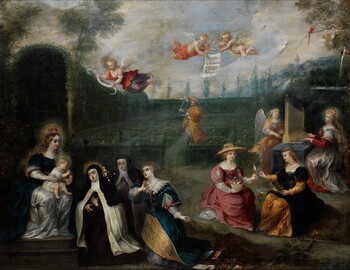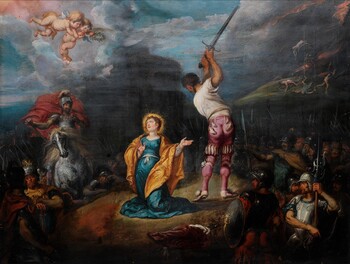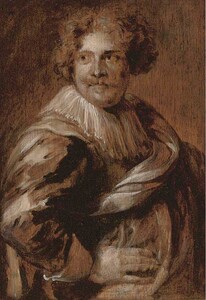6.500 €
The miracle of Saint Isidore the Farmer
Oil on copper : 51,2 X 59,8 cm
Unsigned
Frame : 63,0 X 78,1 cm
I would like to thank Bert Schepers from the Rubenianum in Antwerp who has confirmed the attribution to the previous owner in March 2023.
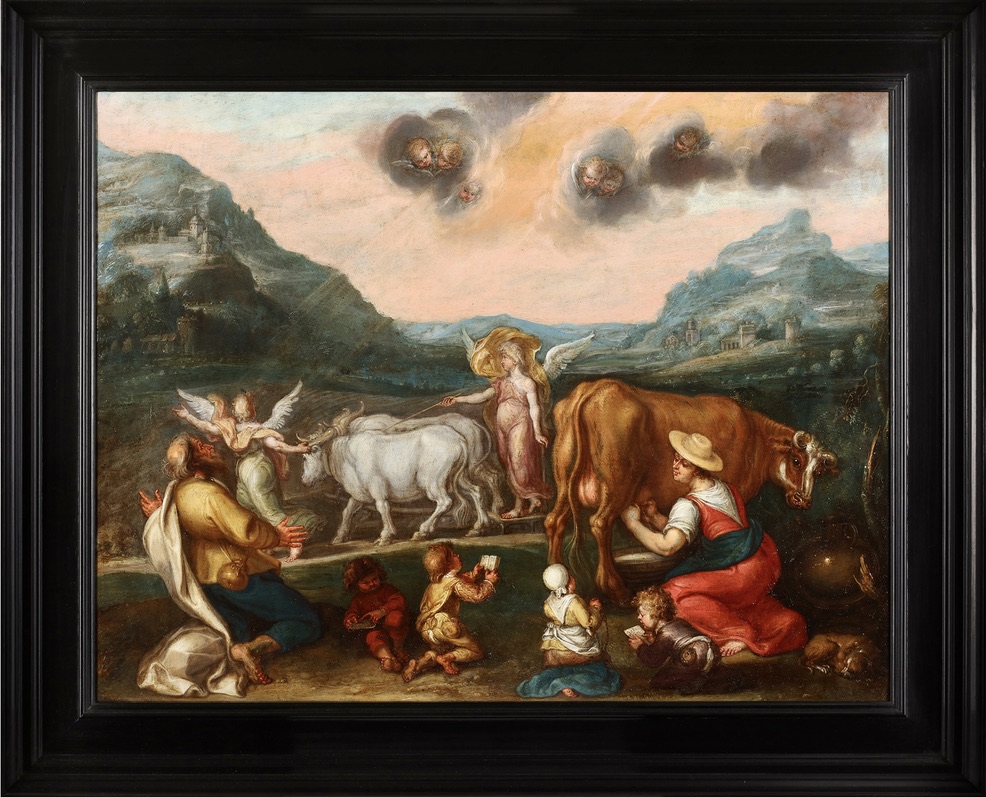
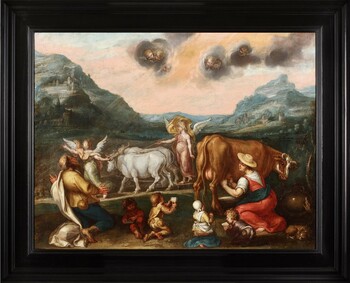
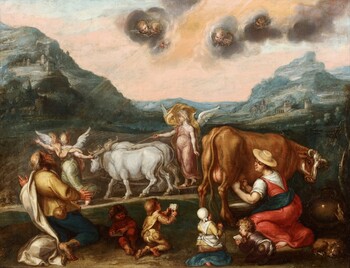
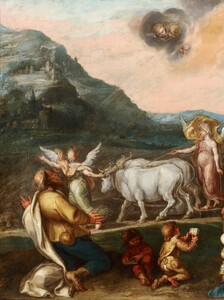
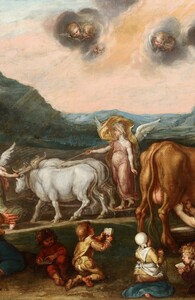
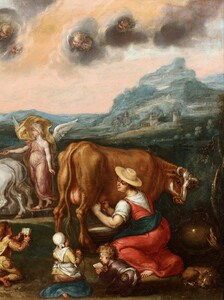
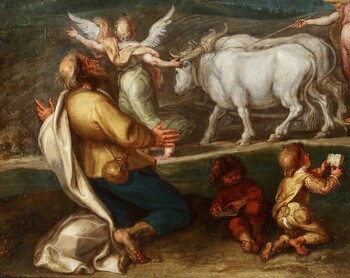
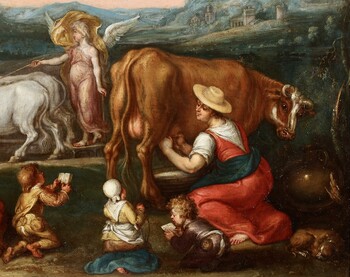
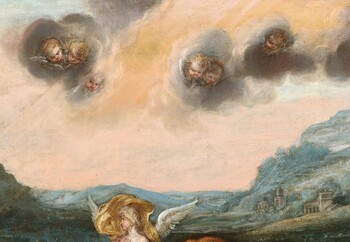
In short
Simon de Vos was a prolific Antwerp painter of interior scenes and of biblical subjects. He produced a fair number of high-quality religious scenes on copper, such as ours, for the art dealers Guillaume Forchondt I and II, who exported these works to Spain and to its colonies in the Americas.
Isidore the Farmer was helped in his work by angels, while he was praying. He lived circa 1100 and was made a saint in 1622: this simple man with an ordinary job had lived a life of holy kindness. In 1615 King Philip III of Spain was cured of a deadly disease when the relics of Isidore were brought to his sickbed.
About Simon de Vos
Flemish painter
Antwerp 1603 – 1676 Antwerp
Prominent painter of genre scenes, of so-called historical subjects (mythological and biblical) and of portraits. He was also an excellent animal painter.
Pupil of Cornelis de Vos (same last name, but not related) since 1615, which was very early as he was only 12 years old. Our painter joined the local Painter’s Guild as a Master in Antwerp in 1620 at the young age of 17.
He married in June 1627 a sister of the still life painter Adriaen van Utrecht; the couple remained childless. There reigns some confusion about his early years, before his marriage: did he stay in Antwerp where he would have joined the Rubens workshop, or did he travel to Italy (Rome and Venice) and Southern France (Aix-en-Provence)? The influence of Theodoor Rombouts, of Jan Cossiers, of Johann Liss and de Vos’ Bamboccianti-influenced early genre scenes all point Southwards, to Italy and also to Aix-en-Provence.
Until the very end of the 1630s de Vos painted mostly smaller genre scenes: merry companies. From circa 1640 onwards he turned to larger, biblical, mythological and allegorical subjects. While his genre scenes seem to have been influenced by Dutch painters, he now fell under the influence of Rubens and van Dyck.
Simon de Vos was a prolific painter. Many of his paintings were exported to the Iberic continent through the important Antwerp art dealers Guillaume Forchondt (also know as Gilliam Forchoudt) the Elder (1608 – 1678) and the Younger (1645 – after 1677). Paintings on copper were especially sought after for the Spanish market, as canvasses often travelled badly to Spain, suffering from rain, while oak panels suffered in Spain and in the colonies in the Americas from the important differences in the level of humidity. Spanish import ports were Bilbao for Madrid and Seville and Cadiz for further export to the Spanish colonies, especially to Veracruz in Mexico. From there on they were sold to convents in Nueva Espana. After the Mexican War of Independence (1810 – 1821) a great number of these paintings returned to Spain during the 19th century.
I should stress here that the Forchondts and their colleagues had two types of painters that they worked with in Anwerp:
- they regularly passed superior commissions to rather famous painters, such as Simon de Vos, Willem van Herp, Pieter van Lint or Abraham Willemsens;
- they hired less qualified painters, so-called “dozen painters” (“Dozijnschilders”), who painted inferior works, copying the style of
famous painters. A lot of these inferior works still flood the old masters market, especially in Spain.
About the subject of our painting
Isidore the Labourer or the Farmer (circa 1070 – 1130) lived in Spain, close to Madrid. He is the patron saint of the farmers and of the city of Madrid. He is strongly venerated in Central America and in the Philippines.
Isidore is known for praying a lot and for his sympathy towards the humble and the animals.
He was canonized in 1622 by Pope Gregory XV, together with Teressa of Avilla and with the founders of the Jesuits, Ignatius of Loyola and Francis Xavier. Already in 1617/18 Rubens had produced two huge, monumental altarpiece paintings for the new church of the Jesuits, dedicated to Our lady, in Antwerp. These paintings, representing miracles by the founders of the Order of the Jesuits, had to support the canonization campaign of Ignatius of Loloya and of Francis Xavier.
The main supporter for the canonization of our Saint Isidore was the Spanish King Philip IV. In 1615, his father, King Philip III had been healed of a deadly fever when the shrine with relics of Isidore were brought into his chamber.
Simon de Vos has represented here Saint Isidore at left praying, while two angels are ploughing the field of his master, the landowner Juan de Vargas, in his place. At right his wife, Maria Torribia (Santa Maria de la Cabeza), is milking a cow.
Why should you buy this painting?
Because this inspiring story is set against a magnificent landscape.
Comparative paintings
Click photos for more details

